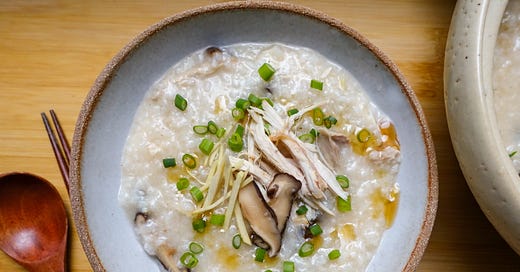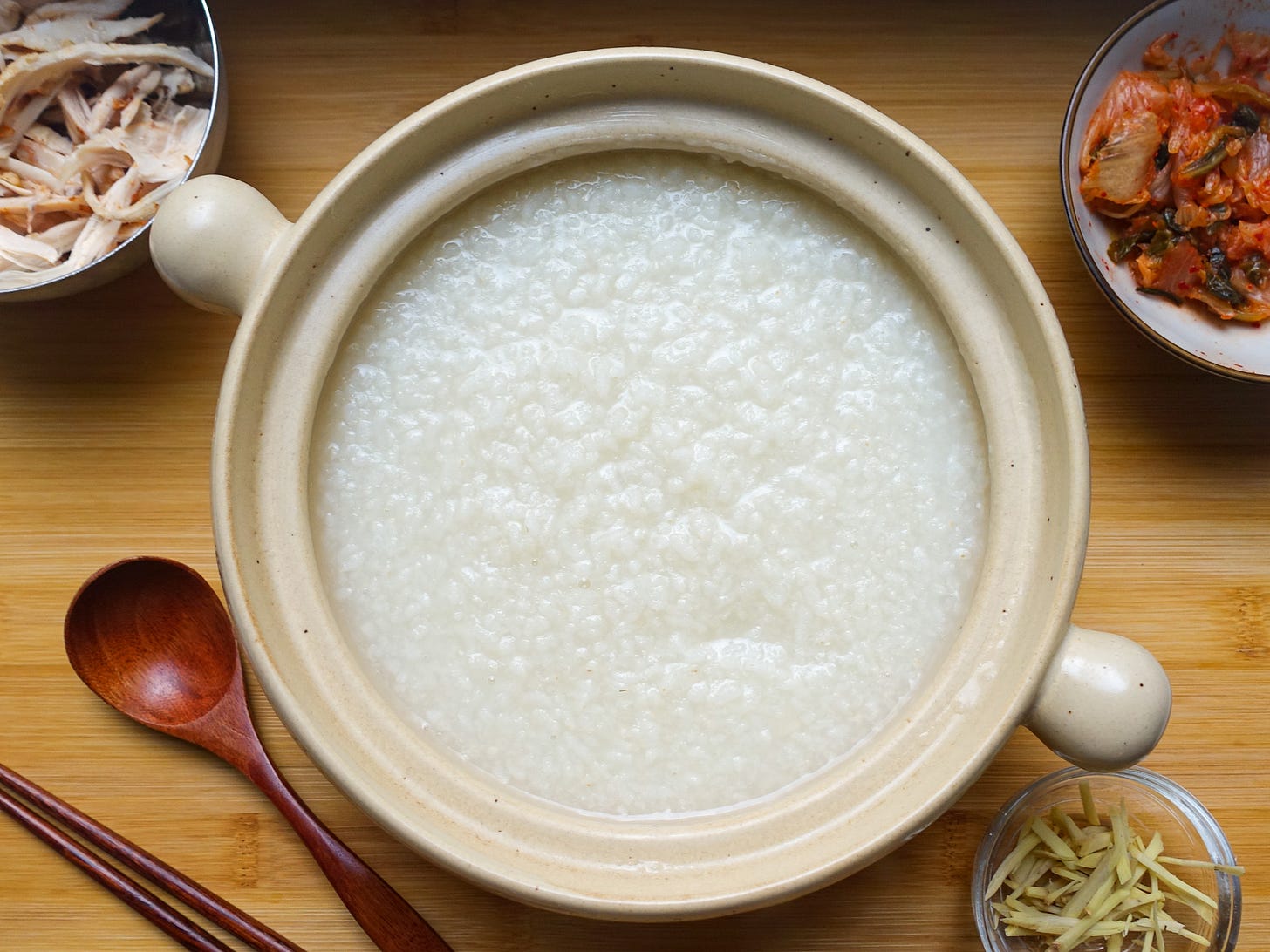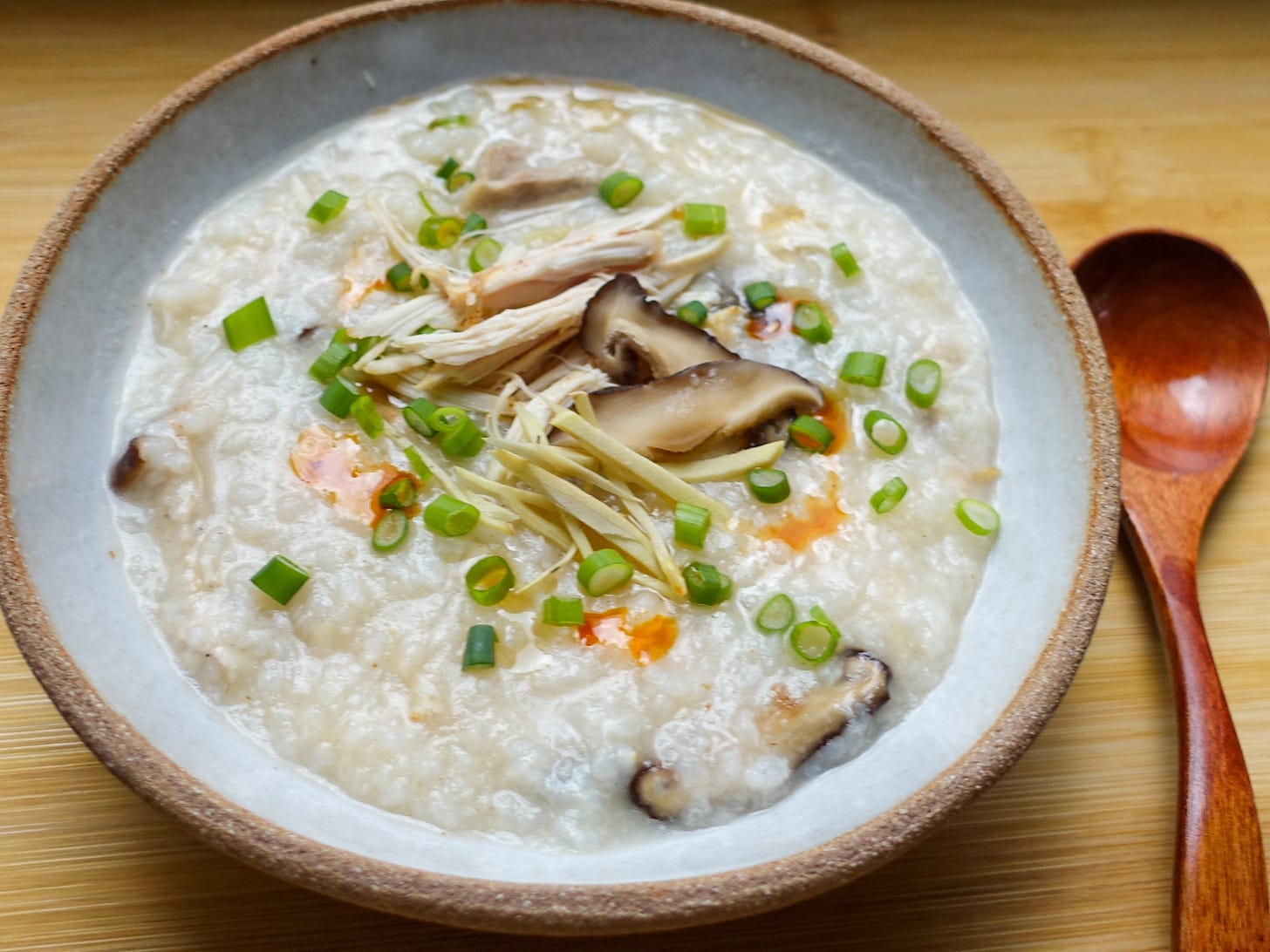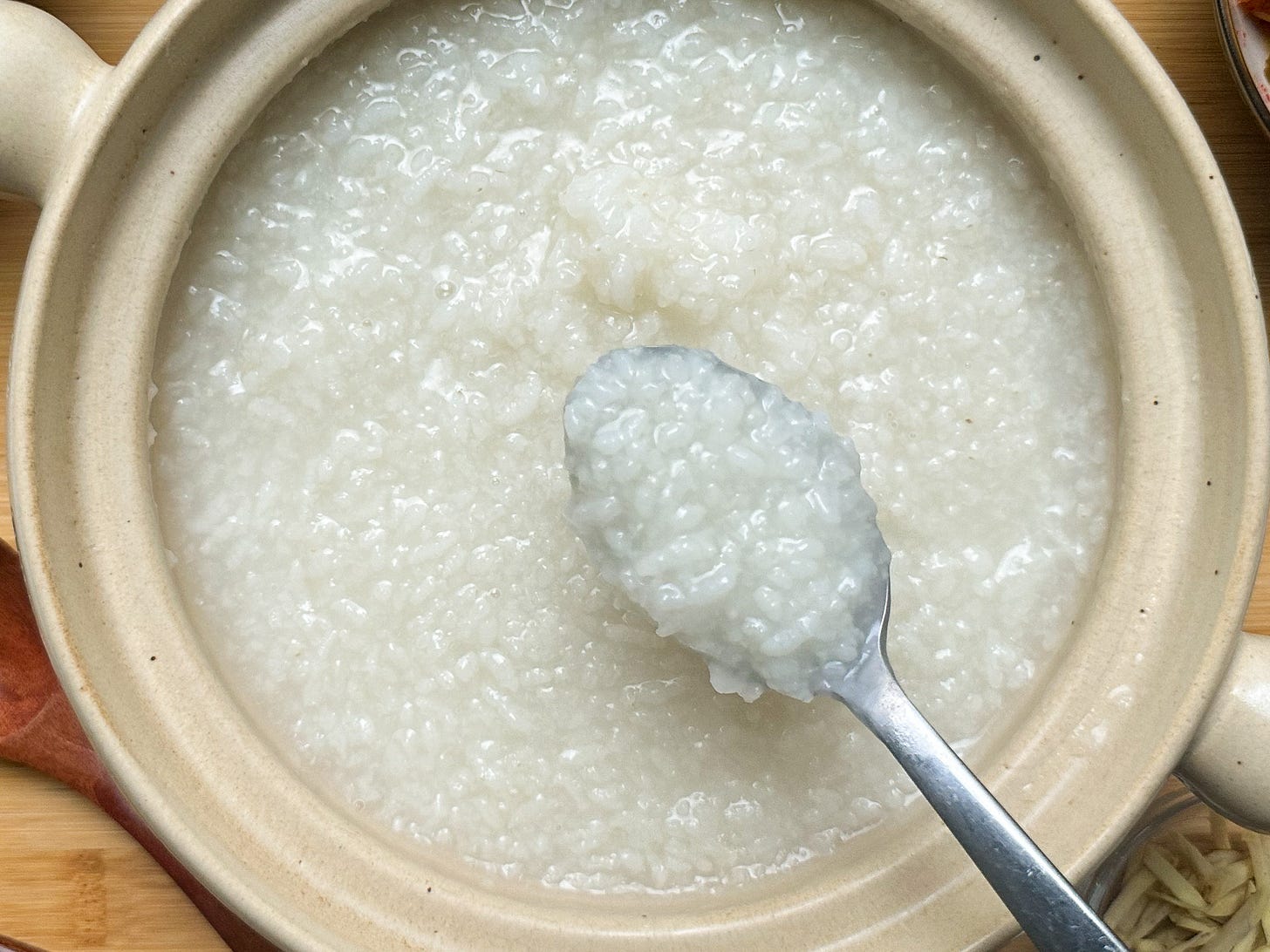When my parents visited me late last year, the household’s congee consumption skyrocketed in my Berlin home. They ate congee for breakfast almost every day. Even when we traveled to Iceland, Mom packed a bag of rice to ensure we had a bowl of steaming rice porridge on the crisp, cold mornings. I held out for two days with yogurt and muesli, but in the end, I caved. That’s when I realized how deeply rooted congee is in my family’s eating habits.
On e of my parents’ favorite eateries back in Sichuan is a mom-and-pop place that serves a congee buffet and steamed baos. Whenever I visit home, they let me sleep in but always leave half a pot of congee on the stove for me. Since moving to Berlin, I don’t eat congee as often as steamed white rice because it takes more time and care. Yet the idea of congee as the ultimate comfort food is somewhat ingrained in my mind. I’ve lost count of how many times I’ve crawled out of a sick bed just to make a pot of congee.
Congee—the Chinese rice porridge—goes by many names. In Sichuan, we call it xi fan (稀饭), while in other parts of China, it may be known as zhou/ jook (粥), or mi (糜)1. Consumed for millennia, congee is synonymous with nourishment and comfort in Chinese cuisine thanks to its easy digestibility. Historically, it has also been a food of survival, prized for its affordability during times of hardship and serving as a relief food during famines in ancient China. In her food memoir, Taiwanese writer Yuchu Hung writes: “Congee is the first and last food”2, recalling how it fed her as an infant and her mother in the final days of battling cancer.
Recipe for chicken and shiitake congee
Tips for making the best white congee
Basic white congee
A good bowl of congee is personal—it reflects individual and regional preferences. In Sichuan, as the name xi fan (diluted cooked rice) suggests, the porridge is thinner, and you can often still see whole kernels of rice. In Cantonese regions, the consistency is thicker, more like a velvety soup. At its core, white congee requires only water and rice. Personally, I prefer a thicker congee where the rice and water blend seamlessly, or as Qing dynasty author Yuan Mei once described: “Only when rice and water blend beautifully—soft and smooth—can it be called zhou. If you only see water or rice, it does not qualify as congee.”3
Recently, I came across a fascinating book compiling Qing dynasty (17-19th century) texts about congee. One text, written by Cao Tingdong, suggests that the best congee requires the right rice, water, heat, and cooking vessel. While many recipes in the book focus on medicinal ingredients (like lotus seeds, jujube dates, or goji berries), these additions remain popular today. Scroll down to the see more tips on how to make white congee.
Recipe for Basic White Congee (白粥, baizhou)
Serving: 1
Ingredients
1/4 cup (55 g) short- or medium-grain white rice
4 cups (950 ml) water (use 5 cups for a runnier consistency)
1 tsp vegetable oil
1/4 tsp salt
Instructions:
Wash the rice 2–3 times. Soak it in a bowl of water with salt and vegetable oil for at least 30 minutes, then drain completely.
Bring 4 cups of water to a boil in a pot. Add the soaked rice, and bring to a boil again. Lower the heat, cover the pot with the lid slightly ajar, and let it simmer over medium heat for at least 40 min. Then check the consistency, normally it takes 1 hour for raw rice, 40 minutes for frozen and soaked rice, and 15 minutes for cooked rice (see note).
Stir occasionally to keep the rice from sticking, and simmer until the congee reaches your desired creamy consistency.
Turn off the heat, cover the pot, and let it rest for 10 minutes before serving. Add your favorite toppings!
Topping ideas: Fermented tofu, pickles of all kinds, kimchi, chili crisp, boiled or fried eggs, Chinese pork floss, century egg
Chicken and Shiitake Congee
In my Sichuan family, we mostly eat white congee, occasionally with add-ins like peanuts, mung beans, corn grits, or sweet potato. Sometimes we mix in pickled mustard greens or tofu pudding.
I’m also a huge fan of Cantonese-style congee, which includes meat, seafood, or vegetables. The thinly sliced meat is added when the congee is simmering hot, a method known as shenggun (生滚) . This recipe is my shortcut version of Cantonese chicken and shiitake congee (香菇鸡粥 or 生滚鸡粥), made with store-bought rotisserie chicken. It’s a one-pot meal, hearty and satisfying. You can also make it with raw chicken (instructions below).
Recipe for Chicken and Shiitake Congee (香菇鸡粥, xianggu jizhou)
Serving: 1
Ingredients
100 g cooked, rotisserie chicken or raw chicken (see note)
2 dried shiitake mushrooms, rehydrated
3 slices of ginger
1 portion of white congee
1 tsp sesame oil
salt to taste
soy sauce to taste
a few drops of chili oil (optional)
chopped scallion for garnishing
Instructions:
Shred leftover cooked chicken or rotisserie chicken in small pieces by hand or with the help of a fork. If you have bones or a carcass, add them to the congee cooking water for flavor but remove before serving. Slice the shiitake mushrooms and ginger.
Once the white congee is ready (before resting), add the ginger and shiitake mushrooms. Simmer for 5 minutes.
Add shredded chicken, stir, and turn off the heat. Let the congee sit for 5 minutes.
Season with salt, soy sauce, and sesame oil. Top with chili oil and chopped scallions if desired.
Note: For raw chicken, thinly slice skinless, boneless chicken breast or thigh. Marinate in 1 tsp light soy sauce, 1/4 tsp white pepper, 1 tsp starch and 1/8 tsp salt. Then coat in 1 tsp vegetable oil. Cook the chicken with the shiitake mushrooms a bit longer (5-10 minutes), until the chicken is fully cooked.
Tips for Making the Best White Congee
Choice of Rice:
The ideal choice is medium- or short-grain white rice, which is starchier and cooks faster. Cao recommends fragrant, new Japonica rice (梗米, or 蓬莱米)4. I usually use jasmine rice for steamed rice, but my mom pointed out it’s not ideal for congee. Now I mostly use Japanese sushi rice (short-grain Japonica rice). That said, in a pinch, jasmine rice works too!
Rice-to-Water Ratio:
For stovetop congee, my base ratio of rice to water is 1:8 (by volume) or 1:20 (by weight). However, variables like the type of rice, heating method, and cooking vessel will affect the final outcome. Adjust as needed. If using a rice cooker, reduce the water (normally Chinese rice cooker has suggested measurements).
Cooking Process:
Cao suggests boiling the water before adding rice and keep the congee simmering while cooking5, which modern recipes also recommend. Keep the pot simmering steadily over medium-low heat. Congee can take anywhere from 30 minutes to several hours, depending on your stove and pot. Start checking at the 30-minute mark to ensure the water hasn’t boiled off completely.
Ways to Speed Up the Process:
Soak the rice: Soak it in water for at least 30 minutes, or even longer to soften it.
Freeze the rice: Freezing breaks down the starch structure, speeding up cooking.
Use cooked rice: The quickest option—ideal if you have leftovers.
Break the Rice While Cooking: To help the rice kernels break down faster, stir vigorously with a whisk or use an immersion blender. Be careful not to over-blend—congee shouldn’t be completely mushy.
Cooking Vessel:
Congee was traditionally made in large iron pots in Sichuan. As a kid, when found black flecks from the pot that appeared in the porridge, elders joked it was “nature’s iron supplement.” Even though every family owns a rice cooker, a pot on the stovetop is still the preferred way to make congee. Cao recommends ceramic pots, but any pot with a lid works: saucepans (my go-to for single portions), clay pots (traditional and visually appealing), stainless steel, or cast iron. Clay and cast iron retain heat better, making them ideal for meat-based congee.
In the past, zhou referred to cooked whole grains, while mi referred to grains that were ground before cooking. However, the distinction is not as clear nowadays.
“糜是最初与最后的食物”,《老派少女购物路线》洪爱珠
“见水不见米,非粥也;见米不见水,非粥也。必使水米融洽,柔腻如一,而后谓之粥”《随园食单》袁枚
“米用粳,以香稻为最”《养生随笔·粥譜說》曹庭栋
“煮时先煮水,以杓扬之数十次,候沸数十次,然后下米。使水性动荡,则输运捷。”《养生随笔·粥譜說》曹庭栋








Big Congee Lover here. What a beautiful and informative post. Do you know if the book you linked is available in English? If I added dried shrimp for an umami boost as suggested above, do I add them as is to the pot? Or do they need a little pre prep?
I love this information on making great congee. Good level of detail to make it taste better!…